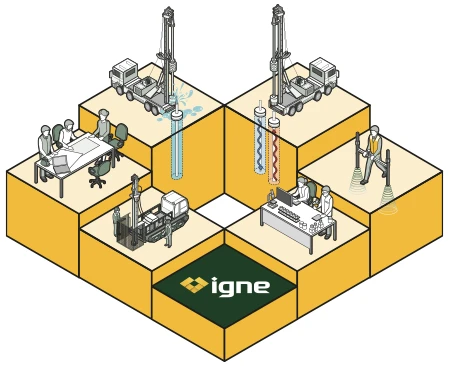

Comprehensive Ground Penetrating Radar (GPR) Surveys for Effective Site Investigation
Ground Penetrating Radar Surveys are a crucial part of comprehensive site investigation, offering non-invasive insight into subsurface features. At Igne, our cutting-edge technology and expert analysis ensure precise and reliable results.
About
What are GPR Surveys in Site Investigation?
Ground-penetrating radar (GPR) surveys are a crucial non-intrusive technique in site investigation, used to detect and map subsurface features.
GPR surveys use radar pulses to image the ground beneath the surface, providing high-resolution data on a range of underground structures and conditions. These surveys are invaluable for identifying foundation and buried obstructions, void detection, and concrete and rebar scanning.
GPR is particularly effective in identifying features that might obstruct or complicate construction, such as pile caps, building foundations, tree roots, and even wildlife habitats like badger setts.
In addition, GPR can be used to locate hidden voids, such as storm, fuel, or septic tanks, which could pose a risk to the stability of a site. For concrete structures, GPR surveys are used to assess the internal conditions of the concrete, detecting rebar, post-tension cables, and potential cracks or weaknesses.
This technology offers a detailed and non-invasive way to understand what lies beneath the surface, ensuring that projects can move forward with minimal risk and maximum efficiency.

Foundation & Buried Obstructions
GPR surveys are widely used to detect buried obstructions that could interfere with construction activities. These include pile caps, building foundations, tree roots, and badger setts.
Pile caps and foundations need to be mapped accurately to avoid conflicts during construction, especially when adding new structures or extending existing ones. Tree roots and badger setts also need to be identified to avoid damage to ecosystems or protected wildlife habitats.
Void Detection
One of the key uses of GPR surveys is in detecting underground voids. Voids can occur naturally or be man-made, such as stormwater tanks, fuel tanks, or septic tanks that may not be documented.
Detecting these voids before construction begins is essential for avoiding collapse risks or unexpected delays. GPR can identify these voids with great precision, enabling proper planning and mitigation measures.
Concrete & Rebar Scanning
For construction projects involving concrete structures, GPR surveys are essential for scanning internal components like rebar and post-tension cables.
GPR can detect these embedded materials without needing to drill or damage the concrete. This is particularly important for assessing the structural integrity of existing buildings or infrastructure, as well as planning for future modifications or additions.
Benefits
Why Commission GPR Surveys?
There are several compelling reasons to commission GPR surveys, and they extend beyond simply avoiding compliance issues. GPR surveys provide valuable data that can save time, money, and effort by identifying subsurface features that might otherwise be overlooked.
Accurate Detection of Subsurface Features
Commissioning a GPR survey allows you to accurately detect and map underground features that might interfere with your project. From foundations and buried obstructions to hidden voids and internal concrete structures, GPR surveys provide a clear picture of what lies beneath the surface, allowing for more informed planning and design decisions.
Minimise Project Risks
Unidentified underground features can lead to significant project delays and unexpected costs. GPR surveys help minimise these risks by identifying potential issues early in the project lifecycle, allowing for adjustments to be made before any digging or construction work begins. This proactive approach helps to avoid unexpected problems and keeps projects on track.
Non-Invasive & Cost-Effective
One of the greatest advantages of GPR surveys is that they are non-invasive. There is no need for drilling or excavation, which saves time and reduces costs. The data is collected quickly and with minimal disruption to the site, making GPR an efficient and cost-effective solution for many types of site investigations.
Preserve Protected Areas & Ecosystems
GPR surveys can also help to identify and protect sensitive environmental features such as tree roots and badger setts. By detecting these features before construction begins, developers can avoid damaging important ecosystems and comply with environmental protection regulations, all while ensuring their project stays on schedule.
Lifecycle
How GPR Surveys for Foundation & Buried Obstructions, Void Detection, and Concrete & Rebar Scanning are Designed, Planned & Carried Out
GPR surveys follow a methodical approach that begins with detailed planning and ends with the collection of highly accurate subsurface data. Below is an outline of how GPR surveys are typically designed, planned, and executed for different applications, including foundation and buried obstructions, void detection, and concrete and rebar scanning.
- Initial Site Assessment & Planning
The first step in a GPR survey is to conduct an initial site assessment. This involves reviewing any available site plans, identifying the key objectives of the survey, and determining the appropriate equipment and methods to be used. The planning phase ensures that the survey targets the correct areas and gathers the necessary data based on the specific needs of the project. - GPR Data Collection
Once the site assessment is complete, the GPR equipment is brought on-site. A radar antenna is moved over the surface of the area to be surveyed, sending radar pulses into the ground. As these pulses hit subsurface structures or materials, they reflect back to the surface and are captured by the antenna. The data is recorded in real-time, allowing the survey team to monitor the results as they are collected. - Foundation & Buried Obstruction Detection
For detecting foundations, buried obstructions, and ecological features like badger setts or tree roots, GPR surveys offer high-resolution imaging that can identify these structures at various depths. The data is analysed to map the exact location and depth of these features, providing the project team with the information needed to avoid potential conflicts during construction. - Void Detection
When detecting underground voids, such as stormwater tanks or septic tanks, GPR is particularly effective at identifying empty spaces beneath the surface. These voids are typically identified by the distinct radar reflections they produce, allowing the survey team to pinpoint their location and size. This data is crucial for planning excavation and construction activities, ensuring that no unexpected voids compromise the stability of the site. - Concrete & Rebar Scanning
For projects involving concrete structures, GPR surveys are used to scan for rebar, post-tension cables, and any potential weaknesses within the concrete. GPR can detect these internal features without the need for drilling or breaking the surface, providing an accurate assessment of the concrete's condition. This is essential for both new construction and the assessment of existing structures. - Data Processing & Reporting
After the survey is complete, the data is processed and analysed by the Igne survey team. The results are compiled into a detailed report, including maps, images, and recommendations for any necessary actions. The report is presented to the client, ensuring that all subsurface features are clearly documented and understood before any construction work begins.
Learn More
Frequently Asked Questions about Ground Penetrating Radar Surveys
- What is a GPR survey?
A GPR or Ground Penetrating Radar survey is a non-invasive method of detecting and mapping subsurface features using radar pulses. It is commonly used in site investigations to identify buried obstructions, foundations, voids, and internal structures within concrete.
- Why are GPR surveys important?
GPR surveys provide critical data that helps avoid potential issues during construction. By detecting buried features and voids, GPR surveys allow project teams to plan more effectively, minimising risks and ensuring that construction proceeds smoothly.
- What can GPR detect?
GPR can detect a wide range of subsurface features, including buried foundations, pile caps, tree roots, badger setts, stormwater tanks, septic tanks, rebar, post-tension cables, and voids. It is a versatile tool used across many different applications in site investigation.
- How deep can GPR surveys penetrate?
The depth of penetration for GPR surveys depends on the frequency of the radar and the material being surveyed. Generally, GPR can detect features up to several metres below the surface, but depth may vary depending on soil conditions and the specific features being detected.
- How long does a GPR survey take?
The duration of a GPR survey depends on the size and complexity of the site. Smaller sites may be completed within a few hours, while larger or more complex areas may take longer.
The data collection process is generally quick and efficient.
- Is GPR safe for the environment?
Yes, GPR is a non-invasive and environmentally friendly survey method. It does not require any digging or drilling, making it a safe option for both the environment and existing site infrastructure.
Learn More about Specific GPR Surveys
The Next Step
Ensure your project proceeds without delays or surprises by commissioning a GPR survey with Igne.
Our experienced team can help you uncover buried obstructions, locate voids, and assess concrete structures, giving you the confidence to move forward.
Explore the full range of GPR and other survey services we offer to de-risk your site investigation and development projects.

Topographical Surveys

Utility Surveys

GPR (Ground Penetrating Radar) Surveys

Measured Building Surveys

Monitoring Surveys

Drone (UAV) Surveys

Bathymetric Surveys

